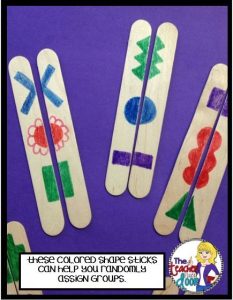Student Contributor: s. Killian
 To help divide the students into groups of 4 or 5 in a more culturally responsive and inclusive way, have students select a color-coded stick at random. Then randomly draw a colored block or paper to let students know where their group will be working.
To help divide the students into groups of 4 or 5 in a more culturally responsive and inclusive way, have students select a color-coded stick at random. Then randomly draw a colored block or paper to let students know where their group will be working.
Before the lesson, prepare popsicle sticks by coloring a spot at the end of the popsicle stick. There should be 4-5 sticks for each color and one color used for each group. The number of groups is determined by class size. When greeting students at the door, have them select a popsicle stick at random. When it is time to divide the class into groups for group work, draw a colored block or colored piece of paper at random to let the group know where they will be working or what station they will start at. I tried this for group work where the students had to rotate to the next station, and it was very time effective and organized. I didn’t have one student complain about what group they were in because all they could think of on the spot is going to the station that had the same color as their stick.
I thought this tool would fit in the preventative phase because it prevents students from choosing the same friends every time for group work. It provides and includes a group for all students and doesn’t leave any students alone to do group work. It would also work in the supportive phase because it is something that keeps the activity or lesson going without stopping to create groups. It fits best in the preventive phase because it helps create friendships and a culturally responsive environment where all students feel welcomed.
More Information –
Tool Source: Dr. Nollmeyer



I tried this with an Urban Kindergarten class of about 20. I wanted to use this tool to avoid students being left out, and arguments over wanting the same partner. Upon using it, I think for Kindergarten there were too many variables on which they could be paired. I did partners first and planned on doing groups of 4 later in the lesson. I did achieve the goals of no one being left out and avoiding arguments. However, it did slow us down a bit during the lesson, because students were too distracted by looking at/playing with their popsicle sticks. I think this could be practiced a bit more, and expectations should be explicitly described beforehand, which I should’ve planned more for considering they are Kindergarten. Otherwise, the tool is fantastic! Easy to create, the students still get “choice”, and the mixing of students can be different almost every time!